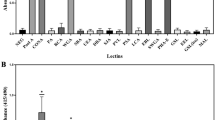Abstract
Helicobacter pylori is a human pathogen associated with gastritis and peptic ulcer. Adhesion properties ofH. pylori to various structures have been described in the literature, including evidence for sialic acid-binding. To study the specificity and frequency of sialic acid-binding, fourteenH. pylori strains were investigated using haemagglutination with derivatized erythrocytes carrying sialic acids only on defined glycans and using haemagglutination inhibition assays. From these studiesH. pylori strains can be grouped into sialic acid-dependent and sialic acid-independent classes. The sialic acid-dependent strains require α-2,3-linked sialic acid for haemagglutination. The potential roles of sialic acid-dependent adhesions forH. pylori-related infections are discussed.
Similar content being viewed by others
Abbreviations
- Sia:
-
sialic acids
- Neu5Ac:
-
N-acetyl-neuraminic acid
- Neu5Gc:
-
N-glycolylneuraminic acid
- Neu5Fm:
-
N-formylneuraminic acid
- Neu5TFA:
-
N-trifluoroacetylneuraminic acid
- RBC:
-
human red blood cells (erythrocytes)
References
Wadström T (1995)Curr Opin Gastroenterol 11: 69–75.
Borèn T, Normark S, Falk P (1994)Trends Microbiol 2: 221–28.
Moran AP, Wadström T (1994)Curr Opin Gastroenterol 10, Suppl. 1: 17–21.
Wadström T, Ascencio F, Ljungh Å, Lelwala-Guruge J, Ringnér M, Utt M, Valkonen K (1993)Europ J Gastroenterol Hepatol 5 Suppl. 2: S12-S15.
Armstrong JA, Cooper M, Goodwin CS, Robinson J, Wee SH, Burton M, Burke V (1991)J Med Microbiol 34: 181–87.
Borèn T, Falk P, Roth KA, Larson G, Normark S (1993)Science 262: 1892–95.
Fauchere J, Blaser MJ (1990)Microbiol Pathol 9: 427–39.
Smoot DT, Resau JH, Naab T, Desbordes BC, Gilliam T, Bull-Henry K, Curry SB, Nidiry J, Sewchand J, Mills-Robertson K, Frontin K, Abebe E, Dillon M, Chippendale GR, Phelps PC, Mobley HLT (1993)Infect Immun 61: 350–55.
Mentis A, Tzouvelekis L, Spiliadis C, Blackwell CC, Weir DM (1990)FEMS Microbiol Immun 64: 125–28.
Ansorg R, Muller K-D, Recklinghausen GV, Nalik HP (1992)Zbl Bakt 276: 323–29.
Gold BD, Huesca M, Sherman PM, Lingwood CA (1993)Infect Immun 61: 2632–38.
Ringnér M, Valkonen KH, Wadström T (1994)FEMS Microbiol Immunol 9: 29–34.
Slomiany BL, Piotrowski J, Sengupta S, Slomiany A (1991)Biochem Biophys Res Commun 175: 963–70.
Trust TJ, Doig P, Emödy L, Kienle Z, Wadström, T, O'Toole P (1991)Infect Immun 59: 4398–404.
Valkonen KH, Wadström T, Moran AP (1994)Infect Immun 62: 3640–48.
Huang J, Keeling PWN, Smyth CJ (1992)J Gen Microbiol 138: 1503–13.
Lelwala-Guruge J, Ljungh Å, Wadström T (1992)APMIS 100: 908–13.
Evans DG, Karjalainen TK, Evans DJ, Graham DY, Lee C-H, (1993)J Bacteriol 175: 674–83.
Varki A (1993)Glycobiology 3: 97–130.
Parkkinen J, Rogers GN, Korhonen T, Dahr W, Finne J (1986)Infect Immun 54: 37–42.
Liukkonen J, Haataja S, Tikkanen K, Kelm S, Finne J (1992)J Biol Chem 267: 21105–11.
Loomes LM, Uemura K-I, Childs RA, Paulson JC, Rogers GN, Scudder PR, Michalski J-C, Hounsell EF, Taylor-Robinson D, Feizi T (1984)Nature 307: 560–63.
Kelm S, Paulson JC, Rose U, Brossmer R, Schmid W, Bandgar BP, Schreiner E, Hartmann M, Zbiral E (1992)Eur J Biochem 205: 147–53.
Paulson JC (1985) InThe Receptors, Vol 2 (Conn M, ed.) pp. 131–219. New York: Academic Press.
Paulson JC, Rogers GN (1987)Methods Enzymol 138: 162–68.
Rogers GN, Herrler G, Paulson JC, Klenk H-D (1986)J Biol Chem 261: 5947–51.
Kelm S, Pelz A, Schauer R, Filbin MT, Tang S, de Bellard M-E, Schnaar RL, Mahoney JA, Hartnell A, Bradfield P, Crocker PR (1994)Curr Biol 4, 965–72.
Kelm S, Schauer R, Manuguerra J-C, Gross H-J, Crocker PR (1994)Glycoconj J 11: 576–85.
Lee A, Hazell SL (1988)Microb Ecol Health Dis 1: 1–16.
Solnick JV, Tompkins LS (1993)Infect Agents Dis 1: 294–309.
Lee H, Kelm S, Michalski J-C, Schauer R (1990)Biol Chem Hoppe-Seyler 371: 307–16.
Brossmer R, Groß H-J (1994)Methods Enzymol 247: 153–76.
Weinstein J, de Souza-e-Silva U, Paulson JC (1982)J Biol Chem 257: 13835–44.
Gillespie W, Kelm S, Paulson JC (1992)J Biol Chem 267: 21004–10.
Wen DX, Livingston BD, Medzihradszky KF, Kelm S, Burlingame AL, Paulson JC (1992)J Biol Chem 267: 21011–19.
Soltesz V, Zeeberg B, Wadström T (1992)J Clin Microbiol 30: 1453–56.
Kelm S, Schauer R (1986)Biol Chem Hoppe-Seyler 367: 989–98.
Potier M, Mameli L, Belisle M, Dallaire L, Melancon SB (1979)Anal Biochem 94: 287–96.
Reuter G, Schauer R (1994)Methods Enzymol 230: 168–99.
Lee H, Kelm S, Yoshino T, Schauer R (1988)Biol Chem Hoppe-Seyler 369: 705–14.
Pritchett TJ, Paulson JC (1989)J Biol Chem 264: 9850–58.
Green ED, Adelt G, Baenziger JU, Wilson S, van Halbeek H (1988)J Biol Chem 263: 18253–68.
Couceiro JNSS, Paulson JC, Baum LG (1993)Virus Res 29: 155–65.
Bode G, Malfertheiner P, Ditschuneit H (1988)Scand J Gastroenterol 23(Suppl. 142): 25–39.
Mullen PJ, Carr N, Milton JD, Rhodes JM (1995)Histopathology 27: 161–7.
Reference added in proof
Schauer R, Kamerling JP (1996) InGlycoproteins (Montreuil J, Schacter H, Vliegenthart JFG, eds) Amsterdam: Elsevier.
Author information
Authors and Affiliations
Rights and permissions
About this article
Cite this article
Hirmo, S., Kelm, S., Schauer, R. et al. Adhesion ofHelicobacter pylori strains toα-2,3-linked sialic acids. Glycoconjugate J 13, 1005–1011 (1996). https://doi.org/10.1007/BF01053196
Received:
Revised:
Issue Date:
DOI: https://doi.org/10.1007/BF01053196




